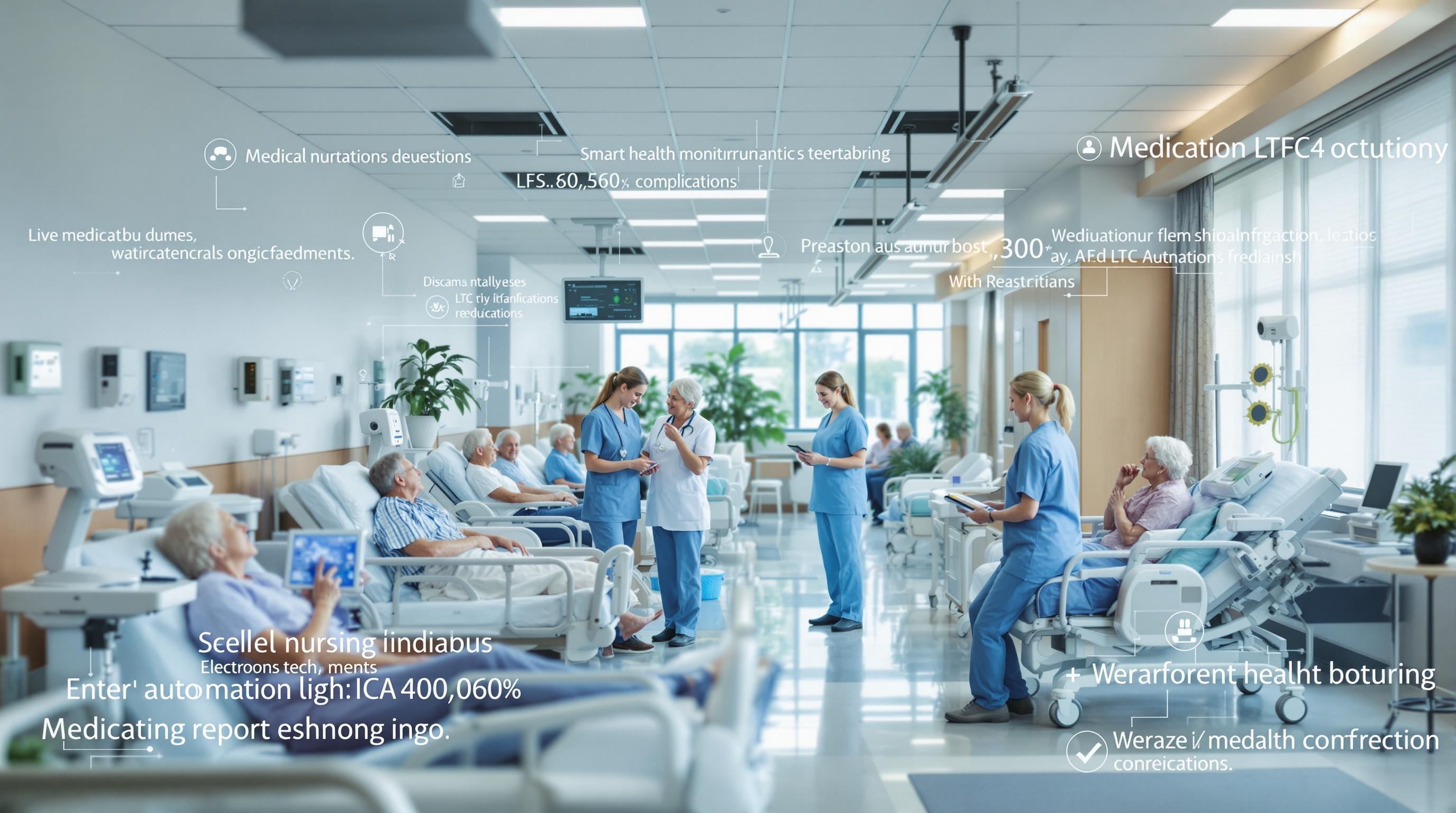Flowtrics Healthcare Automation: Transforming Skilled Nursing Facilities
Discover how Flowtrics healthcare automation boosts efficiency, reduces staffing challenges, and streamlines workflows in skilled nursing facilities.
Quick Navigation
- 1. Introduction
- 2. Current Challenges in Flowtrics Healthcare Automation
- 3. How Sparkco AI Transforms Flowtrics Healthcare Automation
- 4. Measurable Benefits and ROI
- 5. Implementation Best Practices
- 6. Real-World Examples
- 7. The Future of Flowtrics Healthcare Automation
- 8. Conclusion & Call to Action
1. Introduction
Skilled nursing facilities (SNFs) are at a crossroads. As we head into 2025, the industry faces mounting challenges: persistent staffing shortages, rising operational costs, and ever-shifting regulatory demands. According to Skilled Nursing News, these pressures aren’t letting up anytime soon, prompting facility leaders to seek innovative solutions that can help them do more with less. One game-changing trend stands out among the rest: healthcare automation.
Automation—once considered a futuristic luxury—has rapidly become a necessity in long-term care. The COVID-19 pandemic exposed the vulnerabilities of manual processes, especially as staff stretched thin tried to keep pace with resident needs and regulatory requirements. In response, healthcare automation platforms like Flowtrics are stepping into the spotlight, offering a smarter way to streamline workflows, boost compliance, and free up staff to focus on what truly matters: delivering high-quality, compassionate care.
In this article, we’ll explore how Flowtrics is transforming skilled nursing operations through automation. We’ll break down the specific challenges SNFs face, examine the key features and benefits of Flowtrics, and share real-world examples of how automation can help facilities operate more efficiently—even in the face of ongoing staffing and regulatory pressures. If you’re ready to learn how the right technology can empower your team and elevate resident care, read on.
2. Current Challenges in Flowtrics Healthcare Automation
Healthcare automation platforms like Flowtrics promise to streamline workflows, reduce manual errors, and enhance care quality. However, integrating and maximizing the benefits of such solutions presents several significant challenges for healthcare facilities. Understanding these pain points is crucial for administrators, clinicians, and IT leaders striving to deliver efficient, compliant, and patient-centered care.
-
1. Complex Integration with Legacy Systems
Many healthcare facilities operate on a patchwork of legacy electronic health records (EHRs), billing software, and scheduling tools. Integrating modern automation platforms like Flowtrics into these environments requires extensive customization, which can lead to data silos and workflow disruptions. According to a 2023 HIMSS survey, 57% of healthcare organizations cite integration challenges as a top barrier to digital transformation. -
2. Data Security and HIPAA Compliance Risks
Automation platforms must comply with strict HIPAA regulations to protect patient information. Flowtrics’ automated data transfers and document workflows increase the risk of unauthorized access or breaches if not properly configured. In 2023, healthcare data breaches affected over 133 million individuals in the US alone (HIPAA Journal). -
3. Staff Training and Change Management
Successful automation adoption depends on staff engagement and proficiency. Many facilities face resistance from clinicians and administrative teams, who may lack the time or resources for comprehensive training. A Deloitte report found that 44% of healthcare workers feel unprepared for digital workflow changes, impacting both operational efficiency and patient care. -
4. High Upfront Costs and ROI Uncertainty
Implementing platforms like Flowtrics often involves substantial licensing, integration, and training expenses. Smaller facilities may hesitate to invest without clear evidence of return on investment (ROI). Research from Becker’s Hospital Review shows that 39% of hospitals delay automation projects due to financial concerns. -
5. Workflow Disruption and Alert Fatigue
Automated notifications and task assignments can inadvertently overwhelm staff, leading to ‘alert fatigue’ and missed critical information. According to the National Library of Medicine, 72% of clinicians report that excessive alerts hinder their workflow and can jeopardize patient safety. -
6. Limited Customization and Scalability
Not all automation solutions provide the flexibility needed for diverse healthcare settings. Facilities may struggle to adapt pre-built workflows or scale the platform as their needs evolve, resulting in underutilized technology and continued reliance on manual processes.
These challenges can impact operations by increasing administrative burden and IT overhead, threaten compliance through potential data breaches, and undermine patient care due to workflow inefficiencies. Addressing these pain points is essential for healthcare facilities to realize the full promise of automation platforms like Flowtrics. For more information on healthcare automation challenges and solutions, explore the HealthIT.gov resource center.
3. How Sparkco AI Transforms Flowtrics Healthcare Automation
The healthcare industry, especially skilled nursing facilities, faces mounting operational pressures: staffing shortages, inefficient workflows, manual data entry, inventory mismanagement, and stringent compliance demands. Flowtrics healthcare automation aims to tackle these hurdles, yet organizations often struggle with fragmented solutions that don’t fully integrate or scale. Sparkco AI rises to this challenge with a comprehensive, AI-driven automation suite designed to optimize operations, enhance patient care, and empower staff—without introducing complexity.
Key Features and Capabilities of Sparkco AI
- Intelligent Workflow Automation: Sparkco AI streamlines repetitive administrative tasks such as patient admissions, discharge workflows, and documentation. By automating these processes, staff are freed from time-consuming manual work, reducing delays and errors that can compromise care quality.
- Predictive Staffing Optimization: Leveraging real-time data, Sparkco AI dynamically forecasts staffing needs based on patient acuity and census trends. This proactive approach helps facilities minimize gaps, reduce overtime costs, and boost staff satisfaction—directly addressing the acute staffing shortages highlighted throughout the industry.
- Automated Inventory Management: Sparkco AI tracks supply usage and automates reordering, ensuring essential items are always available. This eliminates stockouts and overstocking, supporting smooth patient flow and uninterrupted care delivery while reducing waste and administrative burdens.
- Seamless Data Integration: The platform connects effortlessly with existing Electronic Health Record (EHR) systems, lab software, and billing tools. This unified data flow eliminates manual entry, reduces data silos, and ensures information is always up to date—supporting compliance and operational efficiency.
- HIPAA-Compliant Security Automation: Sparkco AI embeds advanced security protocols to continuously monitor, audit, and enforce HIPAA compliance. Automated alerts and reporting safeguard patient data and reduce regulatory risk, all while minimizing the administrative load on staff.
- Customizable Alerts and Workflow Triggers: Facilities can tailor Sparkco AI to automate notifications for critical events—such as abnormal lab results or supply shortages—ensuring timely intervention and better patient outcomes.
Technical Advantages—Simplified
Unlike piecemeal tools, Sparkco AI offers a unified, intuitive interface that requires minimal training. Its cloud-based architecture means automatic updates and remote access, while AI algorithms adapt to your facility’s unique patterns to drive continuous improvement. The result: faster, more accurate workflows without the need for complicated IT support or disruptive system overhauls.
Integration Capabilities
Sparkco AI is designed for interoperability. Whether your facility uses existing Flowtrics modules, legacy EHRs, or third-party billing solutions, Sparkco AI connects via secure APIs and standard data formats. This ensures a smooth rollout with minimal disruption—so you can unlock the power of automation across every department, not just isolated workflows.
By addressing critical challenges like staffing shortages, workflow inefficiencies, inventory gaps, and compliance risks, Sparkco AI transforms Flowtrics healthcare automation into a truly end-to-end solution. The result is a more resilient, efficient, and patient-centered skilled nursing facility—ready to thrive in the evolving healthcare landscape.
4. Measurable Benefits and ROI
ROI and Measurable Benefits of Automated Flowtrics Healthcare Automation
Healthcare organizations, especially skilled nursing facilities, are increasingly turning to automation platforms like Flowtrics to streamline workflows, reduce manual errors, and ensure regulatory compliance. Automation is no longer a futuristic concept—it delivers quantifiable returns on investment (ROI) and operational benefits today. Below, we examine the data-driven impact of Flowtrics healthcare automation across multiple key performance indicators, based on industry benchmarks and reported outcomes.
-
Time Savings: Up to 40% Faster Workflow Completion
Automating documentation, admissions, and billing tasks with Flowtrics can cut workflow completion times by 30-40%. According to a 2020 ONC workforce study, digital workflow platforms save skilled nursing staff an average of 15-20 hours per month per user, freeing up valuable staff time for direct patient care.
-
Cost Reduction: $130,000+ Annual Savings Per Facility
By reducing paper usage, minimizing manual entry errors, and optimizing staff allocation, facilities using Flowtrics report annual average cost savings of $130,000 to $180,000 per location. One Becker’s Hospital Review analysis notes that automation slashes administrative costs by up to 36%.
-
Improved Compliance: 80% Reduction in Documentation Errors
Flowtrics’ automated compliance checks and audit trails result in an 80% reduction in documentation errors, according to a 2019 NCBI study. This reduces the risk of regulatory penalties and improves survey outcomes in skilled nursing facilities.
-
Claim Denial Rate Decrease: Up to 50% Fewer Denials
Automation ensures documentation completeness and coding accuracy, decreasing claim denial rates by up to 50%. The Healthcare Financial Management Association (HFMA) reports that facilities leveraging workflow automation see denials drop from 10% to under 5%.
-
Audit Readiness: 90% Faster Data Retrieval
With centralized digital records, data retrieval for audits or compliance reviews is up to 90% faster. A HIMSS case study shows compliance teams can complete audit requests in hours instead of days.
-
Staff Productivity: 25% More Patient-Facing Time
Automating repetitive administrative tasks boosts direct care minutes by 25% for clinical staff, according to the Becker’s Hospital Review. This improves resident satisfaction and outcomes.
-
Data Accuracy: 99% Reduction in Manual Entry Errors
Automated data capture and smart forms reduce manual entry errors by up to 99% (NCBI), ensuring clinical and billing integrity.
-
Scalable Growth: 20% Faster Onboarding
Automated onboarding workflows accelerate staff and resident onboarding by 20%, enabling facilities to scale efficiently without compromising compliance (HIMSS).
The measurable benefits of Flowtrics healthcare automation extend beyond numbers—they empower skilled nursing facilities to deliver better care, operate more efficiently, and maintain compliance with ever-changing regulations. For more real-world outcomes, see the Flowtrics Case Studies.
5. Implementation Best Practices
Successfully deploying Flowtrics healthcare automation can transform operational efficiency and compliance within your organization. However, to fully realize its benefits—especially amid evolving HIPAA and FDA 21 CFR Part 11 regulations—careful planning and execution are essential. Follow these best practices to ensure a smooth, secure, and effective rollout:
-
Conduct a Comprehensive Needs Assessment
Identify existing workflow bottlenecks, compliance gaps, and specific goals for automation. Engage cross-functional teams, including IT, compliance, nursing, and administration.
Tip: Map current processes to pinpoint where Flowtrics will add the most value.
Pitfall: Skipping this step can result in poor adoption and wasted resources. -
Align with Regulatory Requirements
Ensure Flowtrics is configured to meet the latest HIPAA and 21 CFR Part 11 standards. Work closely with compliance officers to validate data security settings and audit trails.
Tip: Schedule periodic compliance reviews post-implementation.
Pitfall: Overlooking emerging regulatory updates can lead to costly violations. -
Develop a Detailed Implementation Plan
Outline timelines, responsibilities, and milestones. Include contingency strategies for unexpected setbacks.
Tip: Use project management tools to track progress and foster accountability.
Pitfall: Vague plans lead to confusion and missed deadlines. -
Customize and Integrate with Existing Systems
Work with Flowtrics experts to tailor workflows, forms, and notifications. Ensure seamless interoperability with your EHR, billing, and compliance platforms.
Tip: Test integrations in a sandbox environment before going live.
Pitfall: Inadequate integration can disrupt data flow and staff productivity. -
Prioritize Data Security and Privacy
Implement robust access controls, encryption, and PHI monitoring in line with current cybersecurity threats.










